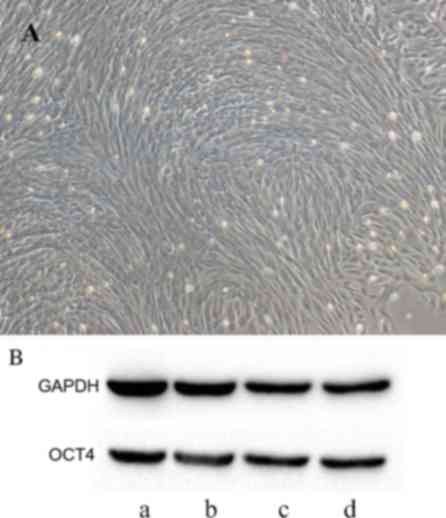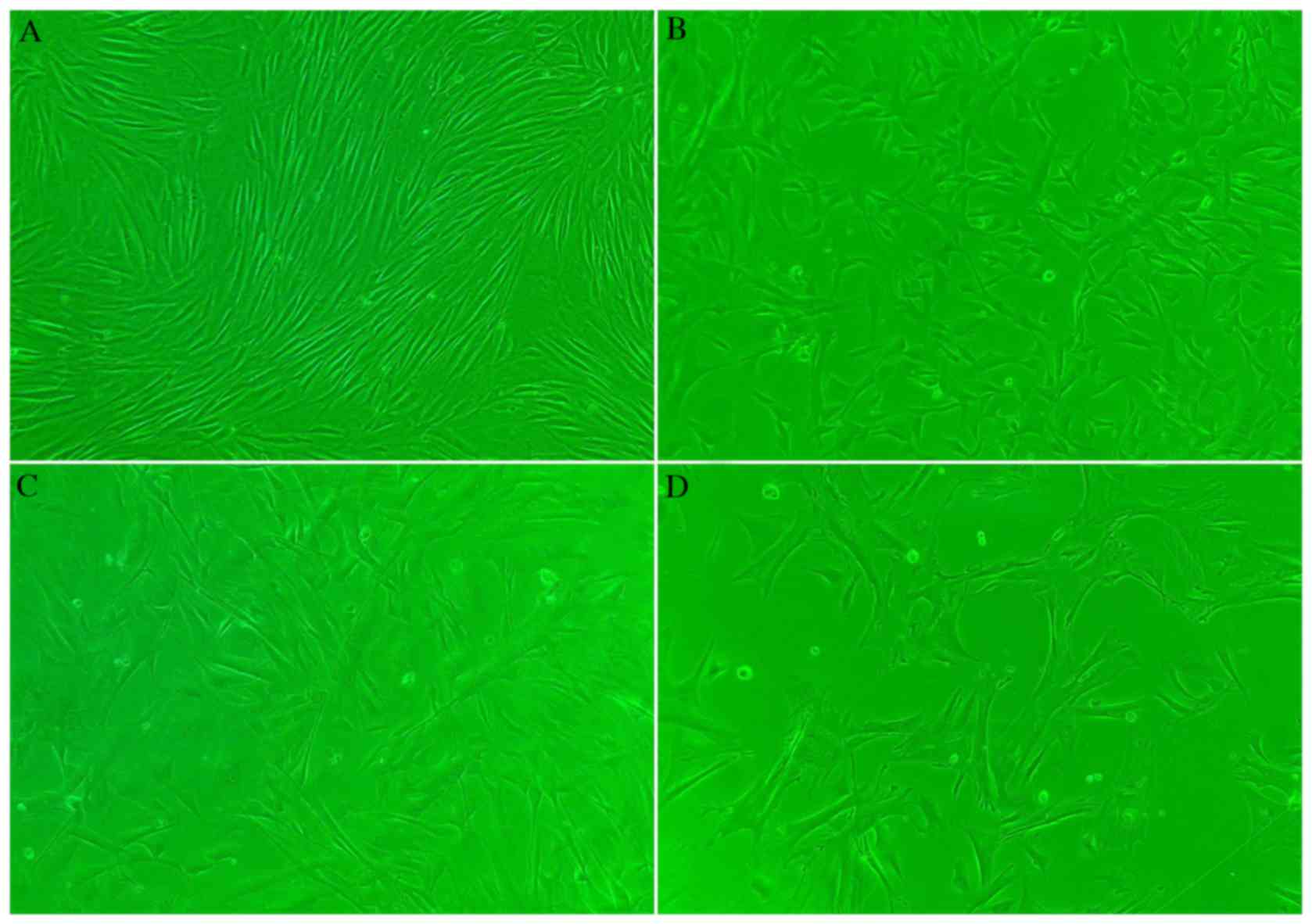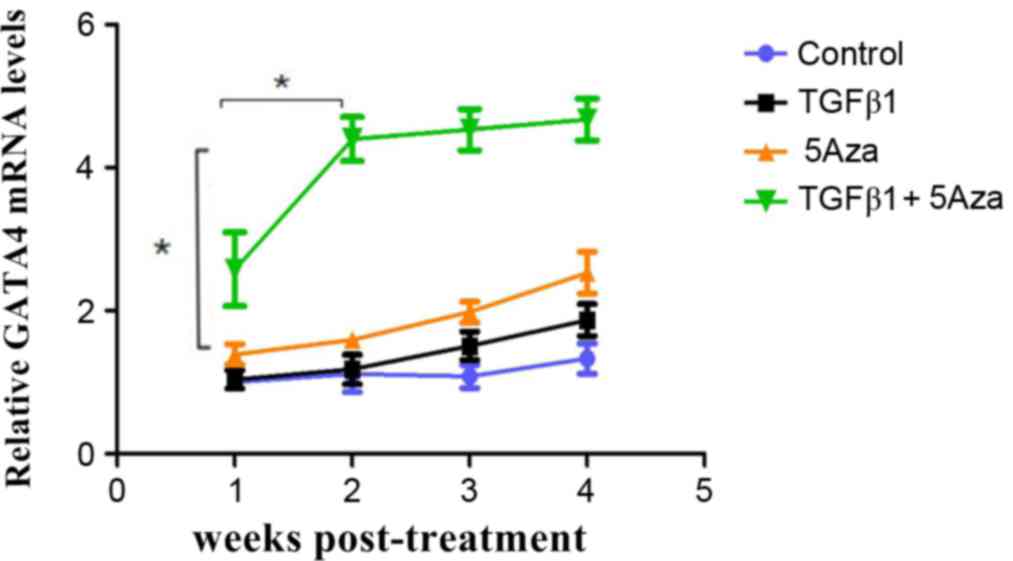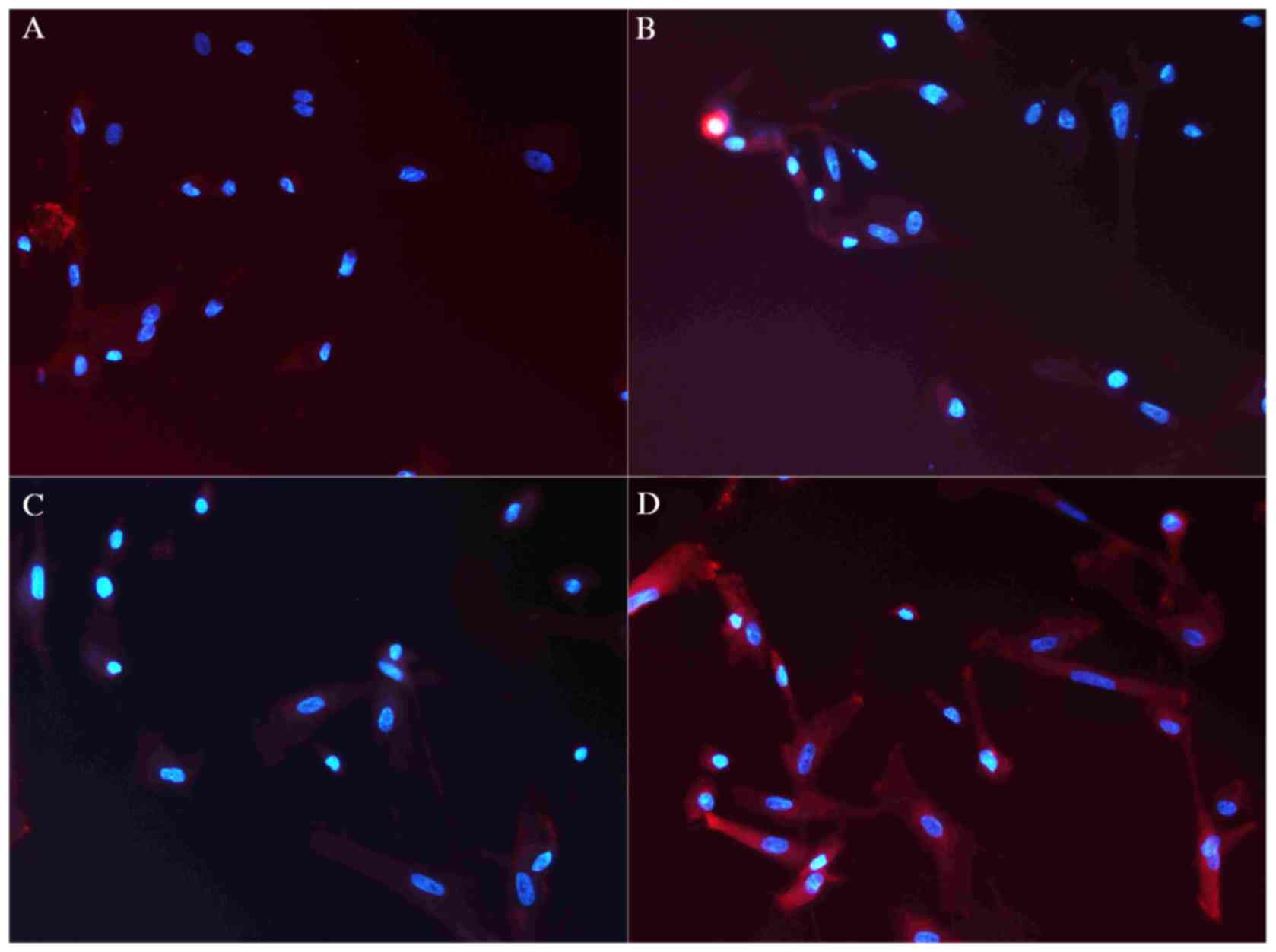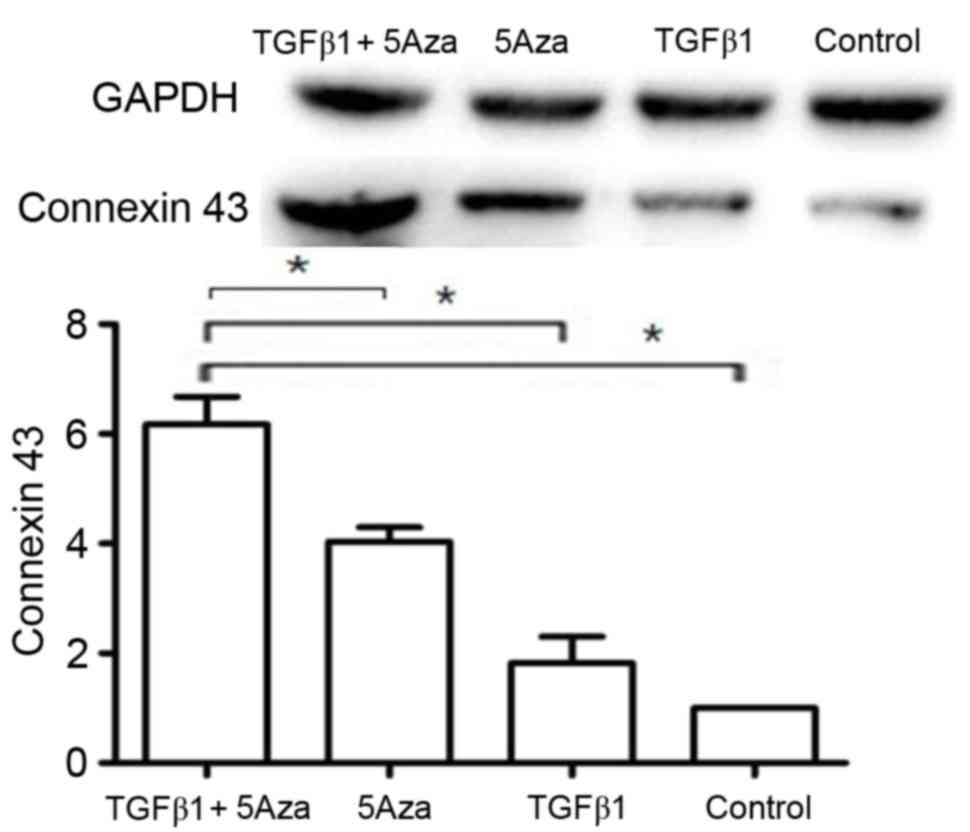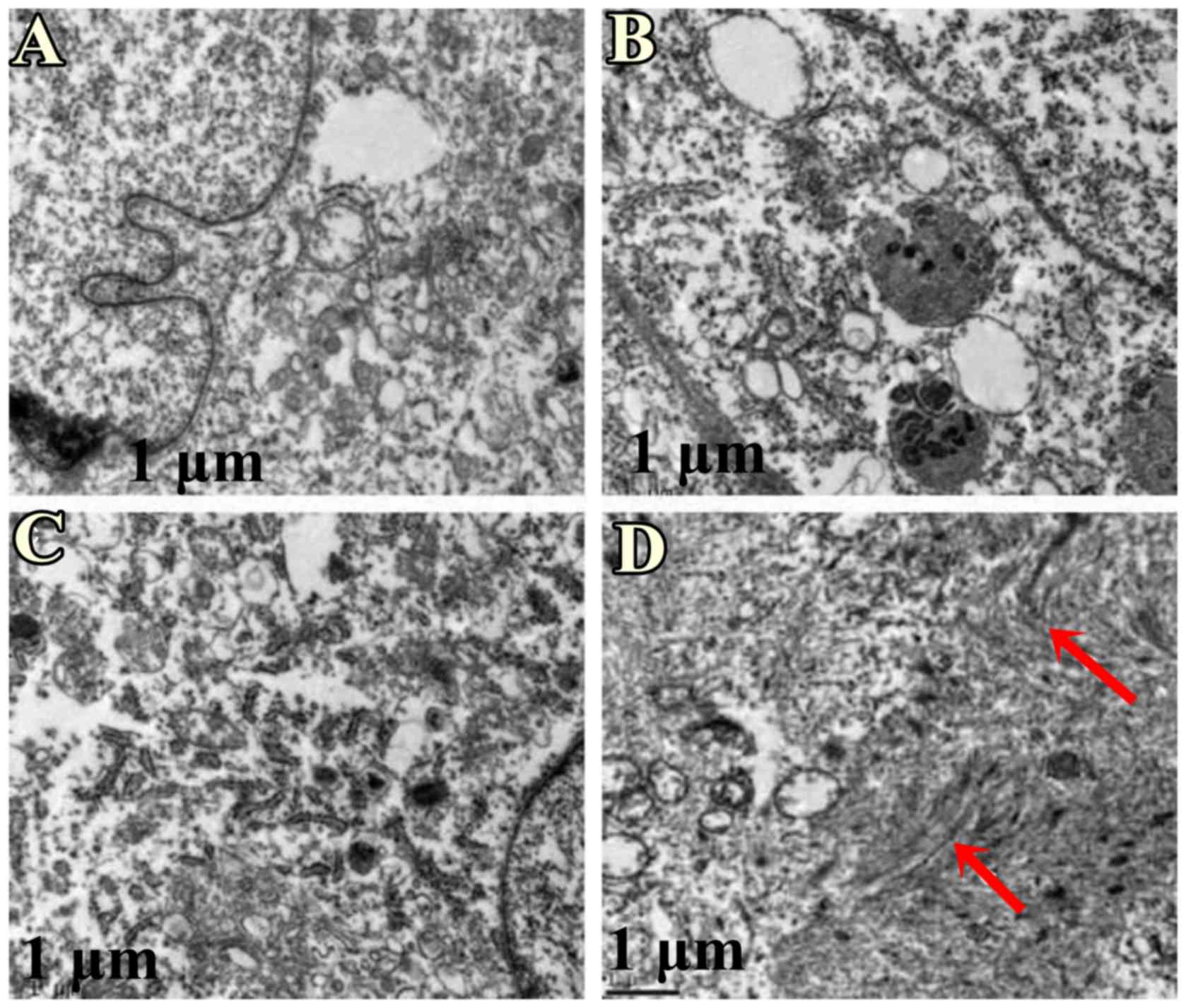|
1
|
Zhao L and Hantash BM: TGF-β1 regulates
differentiation of bone marrow mesenchymal stem cells. Vitam Horm.
87:127–141. 2011. View Article : Google Scholar : PubMed/NCBI
|
|
2
|
Mohanty S, Bose S, Jain KG, Bhargava B and
Airan B: TGFβ1 contributes to cardiomyogenic-like differentiation
of human bone marrow mesenchymal stem cells. Int J Cardiol.
163:93–99. 2013. View Article : Google Scholar : PubMed/NCBI
|
|
3
|
Zhang S, Liu X, Goldstein S, Li Y, Ge J,
He B, Fei X, Wang Z and Ruiz G: Role of the JAK/STAT signaling
pathway in the pathogenesis of acute myocardial infarction in rats
and its effect on NF-κB expression. Mol Med Rep. 7:93–98. 2013.
View Article : Google Scholar : PubMed/NCBI
|
|
4
|
Chiavegato A, Bollini S, Pozzobon M,
Callegari A, Gasparotto L, Taiani J, Piccoli M, Lenzini E, Gerosa
G, Vendramin I, et al: Human amniotic fluid-derived stem cells are
rejected after transplantation in the myocardium of normal,
ischemic, immuno-suppressed or immuno-deficient rat. J Mol Cell
Cardiol. 42:746–759. 2007. View Article : Google Scholar : PubMed/NCBI
|
|
5
|
Benthien JP and Behrens P: Reviewing
subchondral cartilage surgery: Considerations for standardised and
outcome predictable cartilage remodelling: A technical note. Int
Orthop. 37:2139–2145. 2013. View Article : Google Scholar : PubMed/NCBI
|
|
6
|
Fei X, Jiang S, Zhang S, Li Y, Ge J, He B,
Goldstein S and Ruiz G: Isolation, culture and identification of
amniotic fluid-derived mesenchymal stem cells. Cell Biochem
Biophys. 67:689–694. 2013. View Article : Google Scholar : PubMed/NCBI
|
|
7
|
Livak KJ and Schmittgen TD: Analysis of
relative gene expression data using real-time quantitative PCR and
the 2(-Delta Delta C(T)) method. Methods. 25:402–408. 2001.
View Article : Google Scholar : PubMed/NCBI
|
|
8
|
Orlic D, Kajstura J, Chimenti S, Jakoniuk
I, Anderson SM, Li B, Pickel J, McKay R, Nadal-Ginard B, Bodine DM,
et al: Bone marrow cells regenerate infarcted myocardium. Nature.
410:701–705. 2001. View
Article : Google Scholar : PubMed/NCBI
|
|
9
|
Dubuis C, May L, Alonso F, Luca L,
Mylonaki I, Meda P, Delie F, Jordan O, Déglise S, Corpataux JM, et
al: Atorvastatin-loaded hydrogel affects the smooth muscle cells of
human veins. J Pharmacol Exp Ther. 347:574–581. 2013. View Article : Google Scholar : PubMed/NCBI
|
|
10
|
Guan X, Delo DM, Atala A and Soker S: In
vitro cardiomyogenic potential of human amniotic fluid stem cells.
J Tissue Eng Regen Med. 5:220–228. 2011. View Article : Google Scholar : PubMed/NCBI
|
|
11
|
Aseem O, Barth JL, Klatt SC, Smith BT and
Argraves WS: Cubilin expression is monoallelic and epigenetically
augmented via PPARs. BMC Genomics. 14:4052013. View Article : Google Scholar : PubMed/NCBI
|
|
12
|
Xing Y, Lv A, Wang L and Yan X: The
combination of angiotensin II and 5-azacytidine promotes
cardiomyocyte differentiation of rat bone marrow mesenchymal stem
cells. Mol Cell Biochem. 360:279–287. 2012. View Article : Google Scholar : PubMed/NCBI
|
|
13
|
Balana B, Nicoletti C, Zahanich I, Graf
EM, Christ T, Boxberger S and Ravens U: 5-Azacytidine induces
changes in electrophysiological properties of human mesenchymal
stem cells. Cell Res. 16:949–960. 2006. View Article : Google Scholar : PubMed/NCBI
|
|
14
|
Zhang Y, Chu Y, Shen W and Dou Z: Effect
of 5-azacytidine induction duration on differentiation of human
first-trimester fetal mesenchymal stem cells towards
cardiomyocyte-like cells. Interact Cardiovasc Thorac Surg.
9:943–946. 2009. View Article : Google Scholar : PubMed/NCBI
|
|
15
|
Kim YM, Kim J, Heo SC, Shin SH, Do EK, Suh
DS, Kim KH, Yoon MS, Lee TG and Kim JH: Proteomic identification of
ADAM12 as a regulator for TGF-β1-induced differentiation of human
mesenchymal stem cells to smooth muscle cells. PLoS One.
7:e408202012. View Article : Google Scholar : PubMed/NCBI
|
|
16
|
Chen LX, Yang K, Sun M, Chen Q, Wang ZH,
Hu GY and Tao LJ: Fluorofenidone inhibits transforming growth
factor-beta1-induced cardiac myofibroblast differentiation.
Pharmazie. 67:452–456. 2012.PubMed/NCBI
|
|
17
|
Huntgeburth M, Tiemann K, Shahverdyan R,
Schlüter KD, Schreckenberg R, Gross ML, Mödersheim S, Caglayan E,
Müller-Ehmsen J, Ghanem A, et al: Transforming growth factor
β1 oppositely regulates the hypertrophic and contractile
response to β-adrenergic stimulation in the heart. PLoS One.
6:e266282011. View Article : Google Scholar : PubMed/NCBI
|
|
18
|
Wan Safwani WK, Makpol S, Sathapan S and
Chua KH: 5-Azacytidine is insufficient for cardiogenesis in human
adipose-derived stem cells. J Negat Results Biomed. 11:32012.
View Article : Google Scholar : PubMed/NCBI
|
|
19
|
Rosca AM and Burlacu A: Effect of
5-azacytidine: Evidence for alteration of the multipotent ability
of mesenchymal stem cells. Stem Cells Dev. 20:1213–1221. 2011.
View Article : Google Scholar : PubMed/NCBI
|
|
20
|
Zhang S, Zhang M, Goldstein S, Li Y, Ge J,
He B and Ruiz G: The effect of c-fos on acute myocardial infarction
and the significance of metoprolol intervention in a rat model.
Cell Biochem Biophys. 65:249–255. 2013. View Article : Google Scholar : PubMed/NCBI
|
|
21
|
Xu M, Millard RW and Ashraf M: Role of
GATA-4 in differentiation and survival of bone marrow mesenchymal
stem cells. Prog Mol Biol Transl Sci. 111:217–241. 2012. View Article : Google Scholar : PubMed/NCBI
|
|
22
|
Wada R, Muraoka N, Inagawa K, Yamakawa H,
Miyamoto K, Sadahiro T, Umei T, Kaneda R, Suzuki T, Kamiya K, et
al: Induction of human cardiomyocyte-like cells from fibroblasts by
defined factors. Proc Natl Acad Sci USA. 110:12667–12672. 2013;
View Article : Google Scholar : PubMed/NCBI
|
|
23
|
de Lemos JA: Increasingly sensitive assays
for cardiac troponins: A review. JAMA. 309:2262–2269. 2013.
View Article : Google Scholar : PubMed/NCBI
|
|
24
|
Wildi K, Reichlin T, Twerenbold R, Mäder
F, Zellweger C, Moehring B, Stallone F, Minners J, Gimenez M
Rubini, et al: Serial changes in high-sensitivity cardiac troponin
I in the early diagnosis of acute myocardial infarction. Int J
Cardiol. 168:4103–4110. 2013. View Article : Google Scholar : PubMed/NCBI
|
|
25
|
Delmar M and Makita N: Cardiac connexins,
mutations and arrhythmias. Curr Opin Cardiol. 27:236–241. 2012.
View Article : Google Scholar : PubMed/NCBI
|
|
26
|
Thimm J, Mechler A, Lin H, Rhee S and Lal
R: Calcium-dependent open/closed conformations and interfacial
energy maps of reconstituted hemichannels. J Biol Chem.
280:10646–10654. 2005. View Article : Google Scholar : PubMed/NCBI
|
|
27
|
Antunes E, Borrecho G, Oliveira P, Brito
J, Águas A and dos Santos J Martins: Immunohistochemical evaluation
of cardiac connexin43 in rats exposed to low-frequency noise. Int J
Clin Exp Pathol. 6:1874–1879. 2013.PubMed/NCBI
|



